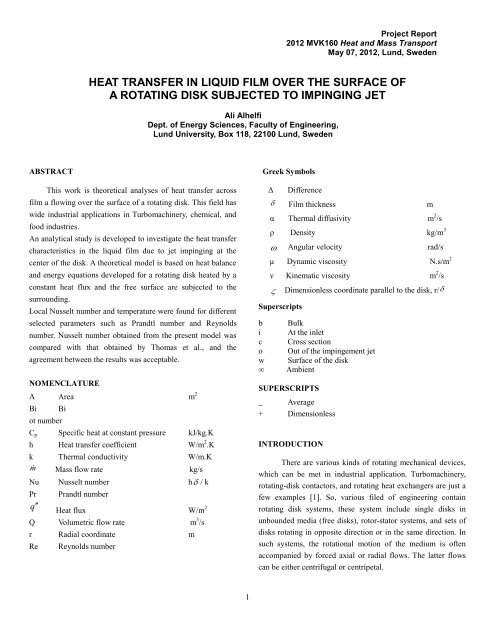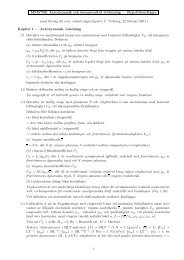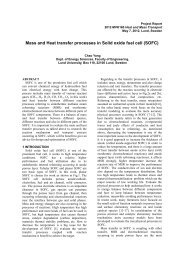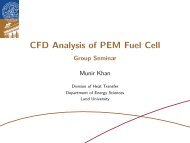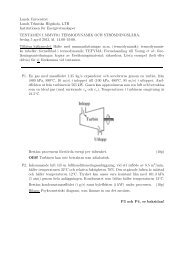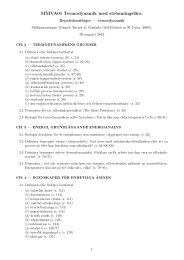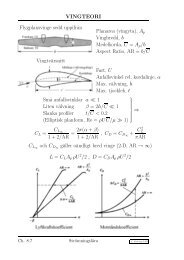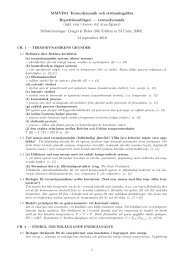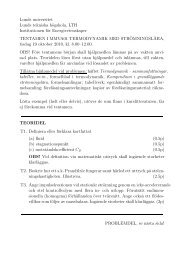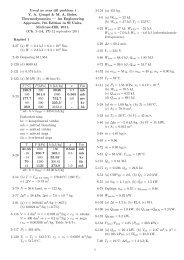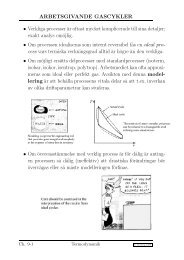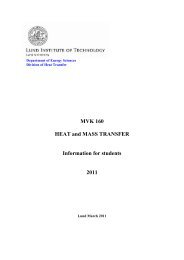heat transfer in liquid film over the surface of a rotating disk ...
heat transfer in liquid film over the surface of a rotating disk ...
heat transfer in liquid film over the surface of a rotating disk ...
Create successful ePaper yourself
Turn your PDF publications into a flip-book with our unique Google optimized e-Paper software.
Project Report<br />
2012 MVK160 Heat and Mass Transport<br />
May 07, 2012, Lund, Sweden<br />
HEAT TRANSFER IN LIQUID FILM OVER THE SURFACE OF<br />
A ROTATING DISK SUBJECTED TO IMPINGING JET<br />
Ali Alhelfi<br />
Dept. <strong>of</strong> Energy Sciences, Faculty <strong>of</strong> Eng<strong>in</strong>eer<strong>in</strong>g,<br />
Lund University, Box 118, 22100 Lund, Sweden<br />
ABSTRACT<br />
This work is <strong>the</strong>oretical analyses <strong>of</strong> <strong>heat</strong> <strong>transfer</strong> across<br />
<strong>film</strong> a flow<strong>in</strong>g <strong>over</strong> <strong>the</strong> <strong>surface</strong> <strong>of</strong> a rotat<strong>in</strong>g <strong>disk</strong>. This field has<br />
wide <strong>in</strong>dustrial applications <strong>in</strong> Turbomach<strong>in</strong>ery, chemical, and<br />
food <strong>in</strong>dustries.<br />
An analytical study is developed to <strong>in</strong>vestigate <strong>the</strong> <strong>heat</strong> <strong>transfer</strong><br />
characteristics <strong>in</strong> <strong>the</strong> <strong>liquid</strong> <strong>film</strong> due to jet imp<strong>in</strong>g<strong>in</strong>g at <strong>the</strong><br />
center <strong>of</strong> <strong>the</strong> <strong>disk</strong>. A <strong>the</strong>oretical model is based on <strong>heat</strong> balance<br />
and energy equations developed for a rotat<strong>in</strong>g <strong>disk</strong> <strong>heat</strong>ed by a<br />
constant <strong>heat</strong> flux and <strong>the</strong> free <strong>surface</strong> are subjected to <strong>the</strong><br />
surround<strong>in</strong>g.<br />
Local Nusselt number and temperature were found for different<br />
selected parameters such as Prandtl number and Reynolds<br />
number. Nusselt number obta<strong>in</strong>ed from <strong>the</strong> present model was<br />
compared with that obta<strong>in</strong>ed by Thomas et al., and <strong>the</strong><br />
agreement between <strong>the</strong> results was acceptable.<br />
NOMENCLATURE<br />
A Area m 2<br />
Bi<br />
ot number<br />
Bi<br />
C p Specific <strong>heat</strong> at constant pressure kJ/kg.K<br />
h Heat <strong>transfer</strong> coefficient W/m 2 .K<br />
k Thermal conductivity W/m.K<br />
m Mass flow rate kg/s<br />
Nu Nusselt number h / k<br />
Pr<br />
q<br />
Prandtl number<br />
Heat flux W/m 2<br />
Q Volumetric flow rate m 3 /s<br />
r Radial coord<strong>in</strong>ate m<br />
Re<br />
Reynolds number<br />
Greek Symbols<br />
Δ<br />
<br />
Difference<br />
Film thickness m<br />
α Thermal diffusivity m 2 /s<br />
ρ Density kg/m 3<br />
<br />
Angular velocity rad/s<br />
µ Dynamic viscosity N.s/m 2<br />
ν K<strong>in</strong>ematic viscosity m 2 /s<br />
Dimensionless coord<strong>in</strong>ate parallel to <strong>the</strong> <strong>disk</strong>, r/<br />
Superscripts<br />
b<br />
i<br />
c<br />
o<br />
w<br />
∞<br />
Bulk<br />
At <strong>the</strong> <strong>in</strong>let<br />
Cross section<br />
Out <strong>of</strong> <strong>the</strong> imp<strong>in</strong>gement jet<br />
Surface <strong>of</strong> <strong>the</strong> <strong>disk</strong><br />
Ambient<br />
SUPERSCRIPTS<br />
_ Average<br />
+ Dimensionless<br />
INTRODUCTION<br />
There are various k<strong>in</strong>ds <strong>of</strong> rotat<strong>in</strong>g mechanical devices,<br />
which can be met <strong>in</strong> <strong>in</strong>dustrial application. Turbomach<strong>in</strong>ery,<br />
rotat<strong>in</strong>g-<strong>disk</strong> contactors, and rotat<strong>in</strong>g <strong>heat</strong> exchangers are just a<br />
few examples [1]. So, various filed <strong>of</strong> eng<strong>in</strong>eer<strong>in</strong>g conta<strong>in</strong><br />
rotat<strong>in</strong>g <strong>disk</strong> systems, <strong>the</strong>se system <strong>in</strong>clude s<strong>in</strong>gle <strong>disk</strong>s <strong>in</strong><br />
unbounded media (free <strong>disk</strong>s), rotor-stator systems, and sets <strong>of</strong><br />
<strong>disk</strong>s rotat<strong>in</strong>g <strong>in</strong> opposite direction or <strong>in</strong> <strong>the</strong> same direction. In<br />
such systems, <strong>the</strong> rotational motion <strong>of</strong> <strong>the</strong> medium is <strong>of</strong>ten<br />
accompanied by forced axial or radial flows. The latter flows<br />
can be ei<strong>the</strong>r centrifugal or centripetal.<br />
1
The <strong>in</strong>terest <strong>in</strong> this subject has <strong>in</strong>creased considerably <strong>over</strong> <strong>the</strong><br />
past few years. Major gas-turb<strong>in</strong>e manufacturers <strong>in</strong> Europe,<br />
U.S.A., and Japan currently fund<strong>in</strong>g a large numbers <strong>of</strong><br />
research projects <strong>in</strong> that direction. In <strong>the</strong> case <strong>of</strong> gas turb<strong>in</strong>e<br />
<strong>disk</strong> cool<strong>in</strong>g, <strong>the</strong> coolant is usually air supplied from <strong>the</strong><br />
compressor section <strong>of</strong> <strong>the</strong> eng<strong>in</strong>e, and its use generally<br />
penalizes <strong>the</strong> eng<strong>in</strong>e cycle performance. Thus <strong>the</strong> objective <strong>of</strong><br />
<strong>disk</strong> cool<strong>in</strong>g scheme design is to provide <strong>the</strong> m<strong>in</strong>imum<br />
necessary coolant consistent with desired eng<strong>in</strong>e life and<br />
reliability. The air supplied to turb<strong>in</strong>e <strong>disk</strong> cool<strong>in</strong>g jets is<br />
usually viewed as hav<strong>in</strong>g two functions. First, it is expected<br />
that <strong>the</strong> high <strong>heat</strong> <strong>transfer</strong> rates normally associated with<br />
imp<strong>in</strong>gement on to stationary <strong>surface</strong>s will be present even<br />
when <strong>the</strong> <strong>surface</strong> is rotat<strong>in</strong>g, and that <strong>the</strong>y will probably be<br />
enhanced by <strong>the</strong> rotation and correspond<strong>in</strong>gly <strong>in</strong>creased relative<br />
velocity between jet and <strong>surface</strong>. Second, it is anticipated that if<br />
multiple jets are used and properly placed, <strong>the</strong>y can prevent <strong>the</strong><br />
undesired radial <strong>in</strong>flow <strong>of</strong> hot combustion gases <strong>in</strong>to <strong>the</strong> cavity<br />
between <strong>the</strong> <strong>disk</strong> and adjacent stationary shroud [2]. Also, an<br />
<strong>in</strong>vestigation, supported by <strong>the</strong> National Aeronautics and Space<br />
Adm<strong>in</strong>istration (NASA-U.S.A), was <strong>in</strong>itiated with <strong>the</strong> primary<br />
objective <strong>of</strong> determ<strong>in</strong><strong>in</strong>g <strong>heat</strong> <strong>transfer</strong> behavior for a variety <strong>of</strong><br />
uniformly spaced imp<strong>in</strong>gement array configuration which<br />
model those <strong>of</strong> <strong>in</strong>terest <strong>in</strong> current and contemplated gas turb<strong>in</strong>e<br />
air foil cool<strong>in</strong>g applications [3].<br />
Fur<strong>the</strong>rmore, <strong>in</strong> many gas-<strong>liquid</strong> <strong>heat</strong> exchangers, <strong>heat</strong><br />
<strong>transfer</strong> performance is controlled by <strong>the</strong>rmal resistance on <strong>the</strong><br />
gas side. Two remedies are available to reduce this resistance:<br />
by <strong>in</strong>creas<strong>in</strong>g <strong>heat</strong> <strong>transfer</strong> area through implementation <strong>of</strong> f<strong>in</strong>s,<br />
and by enhanc<strong>in</strong>g <strong>the</strong> <strong>heat</strong> <strong>transfer</strong> coefficient through<br />
<strong>in</strong>creas<strong>in</strong>g <strong>the</strong> flow or generat<strong>in</strong>g secondary flow. Various<br />
means have been applied to produce secondary flows, for<br />
example oscillation <strong>of</strong> <strong>the</strong> bulk flow, vibration or rotation <strong>of</strong> <strong>the</strong><br />
<strong>surface</strong>, <strong>in</strong>troduction <strong>of</strong> acoustic waves <strong>in</strong>to <strong>the</strong> bulk flow, etc.<br />
In vehicular applications, emphasis on compactness and low<br />
weight discourages not only <strong>surface</strong> addition but also flow<br />
<strong>in</strong>crease as <strong>the</strong> latter will result <strong>in</strong> an <strong>in</strong>crease <strong>in</strong> <strong>the</strong> operat<strong>in</strong>g<br />
pressure, thus requir<strong>in</strong>g <strong>the</strong> re<strong>in</strong>forcement <strong>of</strong> tube or duct walls.<br />
Rotation is one way to achieve <strong>heat</strong> <strong>transfer</strong> enhancement<br />
without suffer<strong>in</strong>g power losses <strong>in</strong> <strong>the</strong> ducts or weight and<br />
volume <strong>in</strong>creases [4]. More<strong>over</strong>, <strong>heat</strong> <strong>transfer</strong> analysis for semiclosed<br />
rotat<strong>in</strong>g <strong>disk</strong> with source flow has been found to be<br />
available to cool high speed memory <strong>disk</strong>s <strong>of</strong> electronic<br />
computers or impellers <strong>of</strong> cryogenic pumps [5].<br />
In contrast, imp<strong>in</strong>g<strong>in</strong>g jets have many applications, <strong>in</strong>clud<strong>in</strong>g<br />
<strong>the</strong> <strong>heat</strong><strong>in</strong>g or dry<strong>in</strong>g <strong>of</strong> food, paper, chemicals, and <strong>the</strong> cool<strong>in</strong>g<br />
<strong>of</strong> combustor components. They are also used <strong>in</strong> glass, metal,<br />
and plastic process<strong>in</strong>g [6].<br />
PROBLEM STATEMENT<br />
In recent years, promotion <strong>of</strong> <strong>heat</strong> <strong>transfer</strong> us<strong>in</strong>g a rotat<strong>in</strong>g <strong>disk</strong><br />
system, with and without, imp<strong>in</strong>gement jet is a matter <strong>of</strong> great<br />
practical importance. The system cool<strong>in</strong>g or <strong>heat</strong><strong>in</strong>g by<br />
imp<strong>in</strong>g<strong>in</strong>g jets has become an established technique, s<strong>in</strong>ce<br />
relatively high local coefficients are obta<strong>in</strong>ed compared with<br />
those for non-imp<strong>in</strong>g<strong>in</strong>g flows. This provides designer with a<br />
means for more effective control <strong>of</strong> <strong>the</strong> temperature <strong>of</strong> <strong>the</strong><br />
system be<strong>in</strong>g <strong>heat</strong>ed or cooled.<br />
LITERATURE SURVEY<br />
In (1987) Sparrow et al [7] described experimentally <strong>the</strong><br />
<strong>heat</strong> <strong>transfer</strong> for a circular jet imp<strong>in</strong>gement on a conf<strong>in</strong>ed <strong>disk</strong>.<br />
The experiments have been performed for a s<strong>in</strong>gle circular jet<br />
imp<strong>in</strong>g<strong>in</strong>g perpendicular to conf<strong>in</strong>ed <strong>disk</strong>, with <strong>the</strong> spent air<br />
be<strong>in</strong>g collected <strong>in</strong> an annulus which surrounds <strong>the</strong> jet delivery<br />
tube. This configuration provides precise control <strong>of</strong> <strong>the</strong> <strong>surface</strong><br />
area affected by <strong>the</strong> imp<strong>in</strong>g<strong>in</strong>g jet and also assures complete<br />
collection <strong>of</strong> <strong>the</strong> spent air. Dur<strong>in</strong>g <strong>the</strong> course <strong>of</strong> <strong>the</strong><br />
experiments, parametric variations were made <strong>of</strong> <strong>the</strong><br />
dimensionless separation distance between <strong>the</strong> jet orig<strong>in</strong> and<br />
<strong>the</strong> imp<strong>in</strong>gement <strong>disk</strong>, <strong>the</strong> ratio <strong>of</strong> <strong>disk</strong> diameter to <strong>the</strong> jet<br />
diameter, and <strong>the</strong> Reynolds number. They showed that <strong>the</strong> <strong>heat</strong><br />
<strong>transfer</strong> coefficient at <strong>the</strong> imp<strong>in</strong>gement <strong>surface</strong> <strong>in</strong>creased<br />
substantially with a decrease <strong>in</strong> <strong>the</strong> jet diameter. Fur<strong>the</strong>rmore,<br />
for smaller diameter jet, <strong>the</strong>re was an optimum separation<br />
distance at which a maximum value <strong>of</strong> <strong>the</strong> <strong>heat</strong> <strong>transfer</strong><br />
coefficient was achieved. Also, for a jet <strong>of</strong> larger diameter, <strong>the</strong><br />
<strong>heat</strong> <strong>transfer</strong> coefficient decreased monotonically as <strong>the</strong><br />
separation distance <strong>in</strong>creased.<br />
In (1988) Goldste<strong>in</strong> and Franchett [8] <strong>in</strong>vestigated<br />
experimentally <strong>the</strong> <strong>heat</strong> <strong>transfer</strong> to a jet imp<strong>in</strong>g<strong>in</strong>g at different<br />
oblique angles to a plane <strong>surface</strong>. The angle between <strong>the</strong> jet<br />
axis and <strong>the</strong> <strong>surface</strong> was varied from 90 to 30 degrees. The<br />
experiment was performed for <strong>the</strong> distance <strong>of</strong> jet orifice to <strong>the</strong><br />
plate rang<strong>in</strong>g from four to ten orifice diameters. The results <strong>of</strong><br />
measurements with <strong>the</strong> range <strong>of</strong> jet Reynolds number from<br />
10000 and 30000. Both <strong>the</strong> jet orifice-to-plate spac<strong>in</strong>g and <strong>the</strong><br />
2
jet angle <strong>in</strong>fluence <strong>the</strong> <strong>over</strong>all shape <strong>of</strong> <strong>the</strong> local Nusselt<br />
number pr<strong>of</strong>iles. The results were <strong>in</strong>dicated that <strong>the</strong> location <strong>of</strong><br />
<strong>the</strong> peak <strong>heat</strong> <strong>transfer</strong> is displaced somewhat from <strong>the</strong><br />
<strong>in</strong>tersection <strong>of</strong> <strong>the</strong> geometric axis <strong>of</strong> <strong>the</strong> jet with <strong>the</strong> plate<br />
<strong>surface</strong>, <strong>the</strong> displacement be<strong>in</strong>g a function primarily <strong>of</strong><br />
imp<strong>in</strong>gement angle. For <strong>the</strong> normal jet <strong>the</strong> local distribution <strong>of</strong><br />
<strong>the</strong> Nusselt number at spac<strong>in</strong>g <strong>of</strong> L/D= 4 and L/D= 6 are very<br />
similar. The local Nusselt numbers near <strong>the</strong> peak for a spac<strong>in</strong>g<br />
<strong>of</strong> L/D= 10 were about 20 percent less than <strong>the</strong> values<br />
measured for <strong>the</strong> spac<strong>in</strong>g <strong>of</strong> 4 and 6. As <strong>the</strong> imp<strong>in</strong>g<strong>in</strong>g jet was<br />
moved from normal, <strong>the</strong> local Nusselt number <strong>in</strong> <strong>the</strong> near peak<br />
region change. The rate at which <strong>the</strong>se local Nusselt numbers<br />
vary with jet angle is dependent on <strong>the</strong> orifice-to-plate spac<strong>in</strong>g.<br />
For <strong>the</strong> smaller spac<strong>in</strong>g, <strong>the</strong> near-peak Nusset numbers are not<br />
significantly effected by <strong>the</strong> <strong>in</strong>itial decreases <strong>in</strong> <strong>the</strong> jet angle.<br />
For a given L/D, <strong>the</strong> slope <strong>of</strong> <strong>the</strong> local Nusselt numbers pr<strong>of</strong>ile<br />
on <strong>the</strong> upstream <strong>in</strong>creases with decreas<strong>in</strong>g jet angles. The slope<br />
<strong>of</strong> local Nessult number pr<strong>of</strong>ile on <strong>the</strong> downstream decreases<br />
with decreas<strong>in</strong>g jet angle. The pr<strong>of</strong>iles with smaller orifice-toplate<br />
spac<strong>in</strong>g and smaller jet angle have steeper pr<strong>of</strong>iles that <strong>the</strong><br />
pr<strong>of</strong>iles with larger spac<strong>in</strong>g and larger angles. Empirical<br />
equation was used to correlate <strong>the</strong> distribution <strong>of</strong> <strong>the</strong> local<br />
Nusselt number.<br />
where: L: distance from jet orifice exit to <strong>heat</strong> <strong>transfer</strong> <strong>surface</strong><br />
D: jet diameter<br />
In (1989) Baughn and Shimizu [9] studied <strong>the</strong> <strong>heat</strong> <strong>transfer</strong><br />
from a <strong>surface</strong> with uniform <strong>heat</strong> flux and an imp<strong>in</strong>g<strong>in</strong>g jet. The<br />
study is concerned with <strong>the</strong> case <strong>of</strong> a s<strong>in</strong>gle circular turbulent<br />
air jet at <strong>the</strong> ambient air temperature imp<strong>in</strong>g<strong>in</strong>g on a flat<br />
stationary <strong>surface</strong>. The distribution <strong>of</strong> <strong>the</strong> Nusselt numbers<br />
along <strong>the</strong> <strong>surface</strong> is given for Reynolds number equal to 23750.<br />
It was shown that one <strong>of</strong> <strong>the</strong> most <strong>in</strong>terest<strong>in</strong>g distributions<br />
occurs when <strong>the</strong> jet is quite close to <strong>the</strong> <strong>surface</strong> (Z/D=2). In this<br />
case, <strong>the</strong> maximum <strong>heat</strong> <strong>transfer</strong> is at <strong>the</strong> stagnation po<strong>in</strong>t; <strong>the</strong><br />
<strong>heat</strong> <strong>transfer</strong> <strong>the</strong>n has a m<strong>in</strong>imum at r/D <strong>of</strong> approximately 1.3,<br />
and ano<strong>the</strong>r maximum at approximately 1.8. As found by o<strong>the</strong>r<br />
<strong>in</strong>vestigators, <strong>the</strong> maximum stagnation po<strong>in</strong>t <strong>heat</strong> <strong>transfer</strong><br />
occurs at a Z/D <strong>of</strong> approximately 6.<br />
where:<br />
Z: distance for jet orifice exit to <strong>the</strong> <strong>surface</strong>.<br />
D: jet diameter<br />
In (1989) Wang et al [10] solved analytically <strong>the</strong> conjugate<br />
problem associated with <strong>heat</strong> <strong>transfer</strong> between a lam<strong>in</strong>ar free<br />
imp<strong>in</strong>g<strong>in</strong>g <strong>liquid</strong> jet and a laterally <strong>in</strong>sulated <strong>disk</strong> with arbitrary<br />
temperature or <strong>heat</strong> flux distribution. The local Nusselt number<br />
was found to depend upon <strong>the</strong> Prandtl number <strong>of</strong> <strong>the</strong> fluid, <strong>the</strong><br />
ratio <strong>of</strong> <strong>the</strong> fluid conductivity to <strong>the</strong> solid conductivity, <strong>the</strong><br />
aspect ratio <strong>of</strong> <strong>the</strong> thickness to <strong>the</strong> radius <strong>of</strong> <strong>the</strong> <strong>disk</strong>, and <strong>the</strong><br />
prescribed temperature or <strong>heat</strong> flux distribution. When <strong>the</strong> solid<br />
conductivity is sufficiently high, <strong>the</strong> prescribed <strong>heat</strong> flux has<br />
little <strong>in</strong>fluence on <strong>the</strong> Nusselt number distribution because <strong>of</strong><br />
high radial conduction. It was found that for a very thick <strong>disk</strong>,<br />
<strong>the</strong> effect <strong>of</strong> prescribed temperature or <strong>heat</strong> flux pr<strong>of</strong>ile on <strong>the</strong><br />
local <strong>heat</strong> <strong>transfer</strong> coefficient was negligible. For a th<strong>in</strong> <strong>disk</strong>, on<br />
<strong>the</strong> o<strong>the</strong>r hand, <strong>the</strong> prescribed temperature or <strong>heat</strong> flux pr<strong>of</strong>ile<br />
has a considerable effect on <strong>the</strong> local <strong>heat</strong> <strong>transfer</strong> coefficient.<br />
Increas<strong>in</strong>g <strong>the</strong> prescribed temperature or <strong>heat</strong> flux with r<br />
enhances <strong>the</strong> local Nusselt number while decreas<strong>in</strong>g <strong>the</strong><br />
prescribed temperature or <strong>heat</strong> flux with r reduces <strong>the</strong> local<br />
Nusselt number. The results also <strong>in</strong>dicated that <strong>the</strong> local <strong>heat</strong><br />
<strong>transfer</strong> coefficient becomes higher when <strong>the</strong> ratio <strong>of</strong> <strong>the</strong> fluid<br />
conductivity to <strong>the</strong> solid conductivity was larger.<br />
In (1996) Cardone et al [11] measured <strong>the</strong> <strong>heat</strong> <strong>transfer</strong> on<br />
a rotat<strong>in</strong>g <strong>disk</strong> for a wide range <strong>of</strong> rotational Reynolds number<br />
values <strong>in</strong> <strong>the</strong> lam<strong>in</strong>ar, transition and turbulent flow regimes.<br />
Measurements were performed by mak<strong>in</strong>g use <strong>of</strong> <strong>the</strong> <strong>heat</strong>ed<br />
th<strong>in</strong>-foil technique and by gaug<strong>in</strong>g temperature maps with an<br />
<strong>in</strong>frared scann<strong>in</strong>g radiometer. The use <strong>of</strong> <strong>the</strong> radiometer is<br />
advantageous on account <strong>of</strong> its relatively good spatial<br />
resolution and <strong>the</strong>rmal sensitivity and because it allows to<br />
easily make measurements down to very low local rotational<br />
Reynolds numbers. Data were obta<strong>in</strong>ed on two <strong>disk</strong>s, hav<strong>in</strong>g an<br />
external diameter <strong>of</strong> 300 mm and 450 mm. Heat <strong>transfer</strong><br />
results presented <strong>in</strong> terms <strong>of</strong> Nusselt and Reynolds numbers<br />
based on <strong>the</strong> local radius, show that almost sudden rise <strong>of</strong> Nu<br />
where Reynolds number around 2.5*10 5 is to be attributed to<br />
<strong>the</strong> onset <strong>of</strong> transition from lam<strong>in</strong>ar to turbulent flow. In <strong>the</strong><br />
lam<strong>in</strong>ar zone, all <strong>the</strong> po<strong>in</strong>ts fall around a straight l<strong>in</strong>e <strong>in</strong> <strong>the</strong> loglog<br />
plan down to very low Reynolds numbers. In <strong>the</strong> fully<br />
turbulent regime data fit <strong>the</strong> relation:<br />
Nu 0.0163Rer<br />
In (1997) Shevchuk and Khalatov [12] improved an<br />
approximation <strong>of</strong> <strong>the</strong> radial velocity pr<strong>of</strong>ile observed <strong>in</strong> a<br />
turbulent boundary layer on a rotat<strong>in</strong>g <strong>disk</strong>, that proposed on<br />
<strong>the</strong> basis <strong>of</strong> <strong>the</strong> assumption that <strong>the</strong> tangent <strong>of</strong> <strong>the</strong> swirl angle <strong>of</strong><br />
<strong>the</strong> flow is described by a quadratic function. The quadratic<br />
approximation used <strong>in</strong> <strong>the</strong> calculations for <strong>the</strong> tangent <strong>of</strong> <strong>the</strong><br />
0.8<br />
3
flow swirl angle <strong>in</strong> <strong>the</strong> boundary layer provides a better<br />
agreement between <strong>the</strong> calculated and experimental pr<strong>of</strong>iles <strong>of</strong><br />
<strong>the</strong> radial velocity. The authors succeeded to obta<strong>in</strong>ed <strong>the</strong><br />
solutions to <strong>the</strong> equations describ<strong>in</strong>g <strong>the</strong> boundary layer and it<br />
was compared <strong>the</strong> solutions with those obta<strong>in</strong>ed by o<strong>the</strong>r<br />
authors for different cases such as, a radial air flow around <strong>the</strong><br />
<strong>disk</strong> and a rotation <strong>of</strong> <strong>the</strong> fluid by <strong>the</strong> law <strong>of</strong> typical <strong>of</strong> a solid<br />
body.<br />
In (1999) Shevchuk and Khalatov [13] Applied an<br />
approximation <strong>of</strong> <strong>the</strong> distribution <strong>of</strong> <strong>the</strong> radial velocity <strong>in</strong><br />
turbulent flow <strong>in</strong> rotat<strong>in</strong>g <strong>disk</strong> systems for calculat<strong>in</strong>g <strong>the</strong><br />
<strong>the</strong>rmal boundary layer, based on a quadratic equation for <strong>the</strong><br />
tangent <strong>of</strong> <strong>the</strong> flow swirl angle. The temperature distribution<br />
was approximated by a power law equation. Analytical results<br />
were obta<strong>in</strong>ed for <strong>the</strong> temperature distributions and <strong>the</strong> ratio <strong>of</strong><br />
<strong>the</strong> thickness <strong>of</strong> <strong>the</strong> <strong>the</strong>rmal and velocity boundary layers. The<br />
authors obta<strong>in</strong>ed <strong>the</strong> solution <strong>of</strong> <strong>the</strong> <strong>in</strong>tegral equations <strong>of</strong> <strong>the</strong><br />
<strong>the</strong>rmal boundary layer under superposed radial flow conditions<br />
and with solid body rotation <strong>of</strong> <strong>the</strong> <strong>liquid</strong>, also it was compared<br />
this solution with published analytical data.<br />
In (1999) Shevchuk [14] presented results <strong>of</strong> simulation <strong>of</strong><br />
turbulent <strong>heat</strong> <strong>transfer</strong> and hydrodynamics <strong>over</strong> a free rotat<strong>in</strong>g<br />
<strong>disk</strong> us<strong>in</strong>g an <strong>in</strong>tegral method based on power law velocity and<br />
temperature pr<strong>of</strong>iles and three different laws for <strong>the</strong> tangent <strong>of</strong><br />
<strong>the</strong> flow swirl angle. It appeared that a quadratic correlation <strong>of</strong><br />
<strong>the</strong> tangent <strong>of</strong> <strong>the</strong> flow swirl angle was <strong>the</strong> most proper one for<br />
a free rotat<strong>in</strong>g <strong>disk</strong>. Result<strong>in</strong>g equation for <strong>the</strong> Nusselt number<br />
was <strong>in</strong> a better agreement with experimental data <strong>of</strong> different<br />
authors.<br />
In (1999) Shevchuk [15] discussed a turbulent centrifugal flow<br />
<strong>in</strong> a gap between parallel rotat<strong>in</strong>g <strong>disk</strong>s, <strong>in</strong> a special case that<br />
<strong>the</strong> flow tangential velocity at <strong>the</strong> <strong>in</strong>let is less than or equal to<br />
<strong>the</strong> tangential velocity <strong>of</strong> <strong>the</strong> <strong>disk</strong>s. The equations <strong>of</strong> a<br />
boundary layer were numerically solved by an <strong>in</strong>tegral method<br />
based on a power approximation <strong>of</strong> <strong>the</strong> tangential velocity and<br />
a quadratic approximation <strong>of</strong> <strong>the</strong> tangent <strong>of</strong> <strong>the</strong> flow swirl<br />
angle. The developed method allowed achiev<strong>in</strong>g significantly<br />
better agreement between <strong>the</strong> results <strong>of</strong> calculation and <strong>the</strong><br />
available experimental data than did various methods.<br />
In (2001) Shevchuk [16] developed <strong>in</strong>tegral method for<br />
predications <strong>of</strong> <strong>heat</strong> <strong>transfer</strong> near a free rotat<strong>in</strong>g <strong>disk</strong> for <strong>the</strong><br />
Prandtl numbers less or equal to unity <strong>in</strong>clud<strong>in</strong>g <strong>the</strong> case <strong>of</strong><br />
Prandtl number tend<strong>in</strong>g to zero. The proposed <strong>in</strong>tegral method<br />
allowed obta<strong>in</strong><strong>in</strong>g an approximate analytical solution for <strong>the</strong><br />
Nusselt number for both lam<strong>in</strong>ar and turbulent flow cases, and<br />
this solution is significantly more accurate than o<strong>the</strong>r known<br />
relationships, especially at almost zero or negative gradients <strong>of</strong><br />
<strong>the</strong> wall temperature. It was shown that <strong>the</strong> accuracy <strong>of</strong> <strong>the</strong><br />
proposed approximate analytical solution for <strong>the</strong> Nusselt<br />
number is substantially higher and <strong>the</strong> Nusselt number<br />
computed from <strong>the</strong> proposed formula does not exceed 3.1%<br />
with respect to <strong>the</strong> exact numerical solution.<br />
In (2001) Usha and Rav<strong>in</strong>dran [17] exam<strong>in</strong>ed numerically <strong>the</strong><br />
development <strong>of</strong> flow and <strong>heat</strong> <strong>transfer</strong> characteristics <strong>of</strong> a <strong>heat</strong><br />
conduct<strong>in</strong>g fluid <strong>film</strong> on a rotat<strong>in</strong>g <strong>disk</strong> for a wide rang <strong>of</strong><br />
Reynolds numbers. They succeeded to solve <strong>the</strong> Navier-Stokes<br />
equations and <strong>the</strong> correspond<strong>in</strong>g energy equation numerically<br />
by a f<strong>in</strong>ite difference method. The results were analyzed for<br />
different values <strong>of</strong> <strong>the</strong> cool<strong>in</strong>g or <strong>heat</strong> dissipat<strong>in</strong>g parameter and<br />
<strong>the</strong> Prandtl number. The formulation was based on <strong>the</strong><br />
follow<strong>in</strong>g assumptions:<br />
i) The free <strong>surface</strong> is <strong>in</strong>itially planar and rema<strong>in</strong>s planar with<br />
sp<strong>in</strong>n<strong>in</strong>g.<br />
ii) The radius <strong>of</strong> <strong>the</strong> <strong>disk</strong> is much larger than <strong>the</strong> <strong>film</strong> thickness,<br />
so <strong>the</strong> edge effect can be neglected.<br />
iii) Thermal stress on <strong>the</strong> free <strong>surface</strong> is neglected.<br />
iv) All physical properties like viscosity, <strong>surface</strong> tension, etc,<br />
are constant and <strong>in</strong>dependent <strong>of</strong> temperature.<br />
They observed that <strong>in</strong>ertial forces have a significant <strong>in</strong>fluence<br />
on <strong>the</strong> flow characteristics, <strong>film</strong> thickness, and on <strong>the</strong><br />
axisymmetric cool<strong>in</strong>g <strong>of</strong> <strong>the</strong> rotat<strong>in</strong>g <strong>disk</strong>. It was fur<strong>the</strong>r noted<br />
that <strong>the</strong> rate <strong>of</strong> th<strong>in</strong>n<strong>in</strong>g <strong>of</strong> <strong>the</strong> fluid <strong>film</strong> is strongly <strong>in</strong>fluenced<br />
by <strong>the</strong> cool<strong>in</strong>g parameter and Prandtl number, when <strong>the</strong> cool<strong>in</strong>g<br />
parameter <strong>in</strong>crease or Prandtl number decreases, <strong>the</strong> <strong>film</strong><br />
thickness <strong>in</strong>crease. And <strong>the</strong> <strong>film</strong> thickness decreases with time<br />
for fixed angular velocity <strong>of</strong> <strong>the</strong> rotat<strong>in</strong>g <strong>disk</strong>. The solution was<br />
useful <strong>in</strong> validat<strong>in</strong>g more realistic analytical or numerical<br />
models <strong>of</strong> <strong>film</strong> cool<strong>in</strong>g on a sp<strong>in</strong>n<strong>in</strong>g <strong>disk</strong>.<br />
ROJECT DESCRIPTION<br />
This work is aimed to study <strong>the</strong> behavior <strong>of</strong> flow and <strong>heat</strong><br />
<strong>transfer</strong> characteristics on <strong>the</strong> <strong>surface</strong> <strong>of</strong> a rotat<strong>in</strong>g <strong>disk</strong>, due to<br />
<strong>the</strong> circular jet <strong>of</strong> <strong>liquid</strong> imp<strong>in</strong>g<strong>in</strong>g at <strong>the</strong> center <strong>of</strong> <strong>the</strong> <strong>disk</strong>.<br />
A <strong>the</strong>oretical model is <strong>in</strong>troduced based on <strong>heat</strong> balance and<br />
energy equations developed for a rotat<strong>in</strong>g <strong>disk</strong> <strong>heat</strong>ed by a<br />
4
constant <strong>heat</strong> flux and <strong>the</strong> free <strong>surface</strong> are subjected to<br />
surround<strong>in</strong>g.<br />
Local Nusselt number and non-dimensional bulk <strong>liquid</strong><br />
temperature are found for parameters such as Prandtl number<br />
and Reynolds number.<br />
The <strong>in</strong>vestigation are limited to imp<strong>in</strong>g<strong>in</strong>g steady,<br />
<strong>in</strong>compressible, and lam<strong>in</strong>ar flow <strong>of</strong> a <strong>liquid</strong> <strong>in</strong> a th<strong>in</strong> <strong>film</strong> on<br />
<strong>the</strong> <strong>surface</strong> <strong>of</strong> a rotat<strong>in</strong>g <strong>disk</strong>. Also, <strong>the</strong> <strong>liquid</strong> <strong>in</strong> this <strong>film</strong> will<br />
be moved radially outward along <strong>the</strong> <strong>disk</strong> under <strong>the</strong> action <strong>of</strong><br />
<strong>the</strong> centrifugal force.<br />
result <strong>in</strong> <strong>the</strong> follow<strong>in</strong>g equation:<br />
2 2<br />
q ro<br />
h r<br />
Tb<br />
[ EXP[<br />
( 1)]<br />
1]<br />
T<br />
2<br />
o<br />
h mc r<br />
p<br />
o<br />
....(4)<br />
Thus it is possible to obta<strong>in</strong> <strong>the</strong> bulk temperature <strong>of</strong> <strong>the</strong> <strong>liquid</strong><br />
at any position r.<br />
HEAT TRANSFER MODEL DUE TO IMPINGING<br />
LIQUID JET<br />
A model is developed to describe <strong>the</strong> flow and <strong>heat</strong> <strong>transfer</strong><br />
characteristics <strong>of</strong> <strong>liquid</strong> <strong>film</strong> flow<strong>in</strong>g <strong>over</strong> <strong>the</strong> <strong>surface</strong> <strong>of</strong> a<br />
rotat<strong>in</strong>g <strong>disk</strong>, due to <strong>the</strong> circular jet <strong>of</strong> <strong>liquid</strong> imp<strong>in</strong>g<strong>in</strong>g at <strong>the</strong><br />
center <strong>of</strong> <strong>the</strong> <strong>disk</strong>. The present study is concerned with <strong>the</strong> case<br />
<strong>of</strong> a s<strong>in</strong>gle circular <strong>liquid</strong> jet at <strong>the</strong> <strong>liquid</strong> temperature (T o ), <strong>the</strong><br />
<strong>liquid</strong> <strong>film</strong> hav<strong>in</strong>g a mass flow rate, and bulk temperature (T b ).<br />
The rotat<strong>in</strong>g <strong>disk</strong> is <strong>heat</strong>ed by a constant <strong>heat</strong> flux, and <strong>the</strong> free<br />
<strong>surface</strong> is subjected to <strong>the</strong> surround<strong>in</strong>g and <strong>the</strong> <strong>heat</strong> <strong>transfer</strong> is<br />
due convection accord<strong>in</strong>g to Newton’s cool<strong>in</strong>g law’s.<br />
1. HEAT BALANCE EQUATION<br />
In order to formulate a ma<strong>the</strong>matical model which enables to<br />
estimate <strong>the</strong> temperature distribution and to f<strong>in</strong>d <strong>the</strong> effect <strong>of</strong><br />
various parameters on <strong>heat</strong> <strong>transfer</strong> process, it is found that <strong>the</strong><br />
<strong>heat</strong> balance equation must be used and as shown <strong>in</strong> Figure 1, it<br />
can be written as:<br />
m<br />
c ( T dT ) mc T [ q h ( T T<br />
)]2<br />
rdr<br />
p<br />
b<br />
b<br />
p<br />
b<br />
b<br />
<br />
....(1)<br />
This equation can be rearranged <strong>in</strong> <strong>the</strong> follow<strong>in</strong>g form, to make<br />
<strong>the</strong> <strong>in</strong>tegration possible:<br />
mc <br />
p<br />
dTb<br />
2<br />
r dr<br />
[ q h ( T T )]<br />
b<br />
<br />
....(2)<br />
In order to f<strong>in</strong>d <strong>the</strong> bulk temperature distribution <strong>in</strong> <strong>the</strong><br />
direction parallel to <strong>the</strong> <strong>disk</strong> <strong>surface</strong>, Equation (2) <strong>in</strong>tegrated<br />
subjected to boundary conditions:<br />
T T<br />
b<br />
o<br />
at<br />
r r<br />
o<br />
, T<br />
To<br />
....(3)<br />
Figure 1: Overall <strong>heat</strong> balance applied to control volume <strong>of</strong> a<br />
th<strong>in</strong> <strong>film</strong> flow <strong>over</strong> <strong>the</strong> <strong>surface</strong> <strong>of</strong> a rotat<strong>in</strong>g <strong>disk</strong> due to<br />
imp<strong>in</strong>g<strong>in</strong>g <strong>liquid</strong>.<br />
2. ENERGY EQUATION<br />
Energy equation is obta<strong>in</strong>ed from <strong>the</strong> first law <strong>of</strong><br />
<strong>the</strong>rmodynamics, which is an expression <strong>of</strong> <strong>the</strong> conservation <strong>of</strong><br />
energy, it states that <strong>the</strong> amount <strong>of</strong> <strong>heat</strong> added to a fluid is equal<br />
to <strong>the</strong> change <strong>in</strong> it’s energy plus any work done by <strong>the</strong> fluid<br />
[18].<br />
For an <strong>in</strong>compressible fluid <strong>the</strong> energy balance is determ<strong>in</strong>ed<br />
by <strong>the</strong> <strong>in</strong>ternal energy, <strong>the</strong> conduction <strong>of</strong> <strong>heat</strong>, <strong>the</strong> convection <strong>of</strong><br />
<strong>heat</strong> with <strong>the</strong> stream, and <strong>the</strong> generation <strong>of</strong> <strong>heat</strong> through<br />
friction. In a compressible fluid <strong>the</strong>re is an additional term due<br />
to <strong>the</strong> work <strong>of</strong> expansion (or compression) when <strong>the</strong> volume is<br />
changed [19].<br />
The forgo<strong>in</strong>g analysis considered <strong>the</strong> fluid dynamics <strong>of</strong> a<br />
lam<strong>in</strong>ar boundary layer flow system. Consider <strong>the</strong> element<br />
control volume shown <strong>in</strong> Figure 2. The follow<strong>in</strong>g assumption<br />
are used to simplify <strong>the</strong> analysis:<br />
• Incompressible steady flow<br />
5
• Constant viscosity, <strong>the</strong>rmal conductivity, and specific <strong>heat</strong> <strong>of</strong><br />
<strong>the</strong> fluid<br />
• Negligible <strong>heat</strong> conduction <strong>in</strong> <strong>the</strong> direction <strong>of</strong> flow<br />
• Negligible <strong>heat</strong> generation due to <strong>the</strong> friction<br />
….(14)<br />
In order to obta<strong>in</strong> <strong>the</strong> temperature pr<strong>of</strong>ile <strong>in</strong> <strong>the</strong> <strong>liquid</strong> layer on<br />
<strong>the</strong> <strong>surface</strong> <strong>of</strong> a rotat<strong>in</strong>g <strong>disk</strong>, equation (7) can be <strong>in</strong>tegrated<br />
subjected to <strong>the</strong> value <strong>of</strong> temperature T = T w at z=0, and after<br />
perform<strong>in</strong>g some arrangement <strong>the</strong> result can be formulated as:<br />
T<br />
1<br />
2<br />
d z q<br />
[ uT]<br />
z <br />
dr 2 k<br />
b<br />
T w<br />
....(9)<br />
<br />
3.<br />
TEMPERATURE DISTRIBUTION<br />
The def<strong>in</strong>ition <strong>of</strong> <strong>the</strong> bulk temperature which is given by:<br />
<br />
<br />
0<br />
T b<br />
<br />
<br />
0<br />
uTdz<br />
udz<br />
....(10)<br />
Figure 2: Elemental control volume for energy analysis <strong>of</strong><br />
lam<strong>in</strong>ar boundary layer.<br />
The energy balance becomes:<br />
<br />
c p<br />
q <br />
[ uT]<br />
<br />
r<br />
z<br />
....(5)<br />
By us<strong>in</strong>g Fourier law <strong>of</strong> <strong>heat</strong> conduction equation (5) becomes:<br />
2<br />
T<br />
[ uT]<br />
<br />
2<br />
r<br />
z<br />
....(6)<br />
In order to simplify <strong>the</strong> solution <strong>of</strong> <strong>the</strong> above equation without<br />
los<strong>in</strong>g <strong>the</strong> accuracy it is possible to assume that <strong>the</strong> gradient <strong>of</strong><br />
(uT) <strong>in</strong> <strong>the</strong> direction <strong>of</strong> flow is equal to <strong>the</strong> gradient <strong>of</strong> (uT) b <strong>in</strong><br />
<strong>the</strong> same direction. This special case is possible especially for<br />
th<strong>in</strong> <strong>liquid</strong> <strong>film</strong>.<br />
By us<strong>in</strong>g <strong>the</strong> above simplification it is possible to write<br />
equation (6) as:<br />
2<br />
d T<br />
[ uT]<br />
b<br />
<br />
2<br />
dr z<br />
....(7)<br />
The velocity pr<strong>of</strong>ile needed <strong>in</strong> <strong>the</strong> above equation to proceed<br />
with temperature distribution is assumed <strong>in</strong> <strong>the</strong> follow<strong>in</strong>g form<br />
[20],<br />
2 2<br />
r<br />
2<br />
u [2( z / ) ( z / ) ]<br />
2<br />
....(11)<br />
The equation that represented <strong>the</strong> temperature difference<br />
between <strong>the</strong> bulk and <strong>the</strong> <strong>disk</strong> <strong>surface</strong> temperature yields:<br />
T T<br />
b<br />
w<br />
9 1 d 5 q<br />
[ uT]<br />
<br />
2<br />
b<br />
<br />
40 dr 8 k<br />
The volumetric flow rate is def<strong>in</strong>ed as:<br />
Q u * A c<br />
....(12)<br />
....(13)<br />
where u is <strong>the</strong> average velocity and Ac is <strong>the</strong> cross section area<br />
and are equal to,<br />
<br />
1<br />
u udz<br />
<br />
<br />
0<br />
….(14)<br />
with boundary conditions:<br />
A<br />
r<br />
c<br />
2<br />
…..(15)<br />
T<br />
z<br />
q<br />
<br />
k<br />
at<br />
z 0<br />
....(8)<br />
<strong>the</strong> average velocity can be written as:<br />
6
2 2<br />
r<br />
u <br />
3<br />
....(16)<br />
Substitution <strong>of</strong> Equation (16) <strong>in</strong>to Equation (13) to <strong>in</strong>dicate <strong>the</strong><br />
relation between <strong>the</strong> flow rate and <strong>the</strong> <strong>film</strong> thickness, <strong>the</strong> result<br />
can be written <strong>in</strong> <strong>the</strong> follow<strong>in</strong>g form:<br />
r<br />
i(<br />
)<br />
r<br />
o<br />
2 / 3<br />
....(17)<br />
Differentiat<strong>in</strong>g Equation (17) and (4) to obta<strong>in</strong> <strong>the</strong> <strong>film</strong><br />
thickness and bulk temperature pr<strong>of</strong>iles with respect to radial<br />
coord<strong>in</strong>ate <strong>the</strong> result will be:<br />
T T<br />
b<br />
w<br />
r<br />
( )<br />
r<br />
2<br />
o<br />
2 / 3<br />
3m<br />
c <br />
p<br />
<br />
iq<br />
r<br />
( )<br />
80<br />
k r h r<br />
o<br />
o<br />
[<br />
8 / 3<br />
9<br />
40<br />
2<br />
q<br />
i<br />
ro<br />
h r<br />
EXP[<br />
(<br />
k m<br />
c r<br />
r<br />
[ EXP[<br />
<br />
m<br />
c<br />
2<br />
o<br />
p<br />
r<br />
(<br />
r<br />
2<br />
2<br />
o<br />
p<br />
2<br />
2<br />
o<br />
5 q<br />
i<br />
1)]<br />
] <br />
8 k<br />
3m<br />
c<br />
p<br />
<br />
iTo<br />
1)]<br />
1]<br />
<br />
2<br />
80<br />
k rO<br />
r<br />
( )<br />
r<br />
The above equation gives <strong>the</strong> temperature difference between<br />
<strong>the</strong> bulk and wall temperature at any local value <strong>of</strong> r.<br />
Us<strong>in</strong>g <strong>the</strong> dimensionless variables:<br />
T<br />
T<br />
<br />
b<br />
<br />
w<br />
( T<br />
<br />
( T<br />
<br />
T ) h<br />
T ) h<br />
h.<br />
<br />
Nu <br />
k<br />
c<br />
p<br />
Pr <br />
k<br />
h ro<br />
Bi <br />
k<br />
4m<br />
Re <br />
2<br />
r <br />
R <br />
r<br />
r<br />
o<br />
b<br />
w<br />
q<br />
q<br />
o<br />
o<br />
o<br />
<br />
<br />
<br />
<br />
<br />
<br />
<br />
<br />
<br />
<br />
<br />
<br />
<br />
<br />
<br />
<br />
<br />
<br />
<br />
<br />
<br />
o<br />
..... (19)<br />
8<br />
<br />
3<br />
….(18)<br />
RESULTS AND DISCUSSIONS<br />
Attention is focused on determ<strong>in</strong>ation <strong>of</strong> parameters, which are<br />
considered necessary for describ<strong>in</strong>g <strong>the</strong> behavior <strong>of</strong> <strong>the</strong><br />
developed model and expla<strong>in</strong><strong>in</strong>g <strong>the</strong> <strong>heat</strong> <strong>transfer</strong><br />
characteristics. These parameters are composed <strong>of</strong> <strong>the</strong> bulk<br />
temperature <strong>of</strong> <strong>the</strong> <strong>liquid</strong> <strong>film</strong>, and <strong>the</strong> local Nusselt number<br />
along <strong>the</strong> flow. The calculation <strong>of</strong> each <strong>of</strong> <strong>the</strong> above mentioned<br />
parameters is tak<strong>in</strong>g <strong>in</strong>to consideration <strong>the</strong> effect <strong>of</strong> several<br />
important parameters such as <strong>heat</strong> flux, volumetric flow rate,<br />
and <strong>heat</strong> <strong>transfer</strong> coefficient <strong>of</strong> surround<strong>in</strong>g. The results <strong>of</strong> <strong>the</strong><br />
calculation above are described below.<br />
1. EFFECT OF HEAT FLUX<br />
Effect <strong>of</strong> <strong>heat</strong> flux on <strong>the</strong> <strong>heat</strong> <strong>transfer</strong> characteristics is shown<br />
<strong>in</strong> figures 3–5. Each figure composed <strong>of</strong> five plotted curves for<br />
<strong>the</strong> selected values <strong>of</strong> <strong>heat</strong> flux. The effect <strong>of</strong> <strong>heat</strong> flux can be<br />
expla<strong>in</strong>ed for each <strong>of</strong> <strong>the</strong> follow<strong>in</strong>g result as:<br />
i- Effect on bulk temperature<br />
Figure 3 reflect <strong>the</strong> effect <strong>of</strong> <strong>heat</strong> flux on <strong>the</strong> bulk temperature<br />
along <strong>the</strong> flow. In this figure, for a fixed value <strong>of</strong> <strong>heat</strong> flux, <strong>the</strong><br />
<strong>in</strong>crement <strong>in</strong> radial distance means expos<strong>in</strong>g <strong>the</strong> <strong>liquid</strong> <strong>film</strong> to<br />
higher quantity <strong>of</strong> <strong>heat</strong> due to <strong>in</strong>creas<strong>in</strong>g <strong>the</strong> exposed area and<br />
<strong>the</strong> fixed <strong>heat</strong> flux. This behaviour caused an <strong>in</strong>crease <strong>in</strong> <strong>the</strong><br />
bulk temperature <strong>of</strong> <strong>the</strong> <strong>liquid</strong> <strong>film</strong>. On <strong>the</strong> o<strong>the</strong>r hand,<br />
<strong>in</strong>creas<strong>in</strong>g <strong>heat</strong> flux cases <strong>the</strong> bulk temperature at fixed position<br />
to <strong>in</strong>crease <strong>in</strong> <strong>the</strong> same manner.<br />
The temperature distribution <strong>in</strong> dimensionless form can be<br />
rewritten as,<br />
9<br />
2Bi<br />
2 5 3Re Pr Nu<br />
T<br />
<br />
w<br />
T<br />
<br />
b<br />
Nu.<br />
EXP[<br />
( R 1)]<br />
Nu <br />
2<br />
40 Re Pr 8 160BiR<br />
2Bi<br />
2 3Re Pr Nu Toh<br />
[ EXP[<br />
( R 1)]<br />
1]<br />
( )<br />
....(20)<br />
2<br />
Re Pr<br />
160BiR<br />
q<br />
7<br />
Figure 3: Effect <strong>of</strong> <strong>heat</strong> flux on bulk temperature<br />
distribution along a rotat<strong>in</strong>g <strong>disk</strong> with, Q=1( l /m<strong>in</strong>),<br />
h=50(W/ m 2 .K) and r o =0.05m
ii- Effect on <strong>heat</strong> <strong>transfer</strong> coefficient<br />
The behavior <strong>of</strong> <strong>heat</strong> <strong>transfer</strong> coefficient with <strong>heat</strong> flux is<br />
shown <strong>in</strong> figure 4. From this figure it is clear that, for a fixed<br />
<strong>heat</strong> flux <strong>the</strong> <strong>heat</strong> <strong>transfer</strong> coefficient <strong>in</strong>crease along <strong>the</strong> flow.<br />
This is due to decrease <strong>in</strong> <strong>the</strong> <strong>film</strong> thickness with <strong>in</strong>creas<strong>in</strong>g <strong>the</strong><br />
radial distance.<br />
2. EFFECT OF FLOW RATE<br />
Figures 6-8, clarify <strong>the</strong> effect <strong>of</strong> flow rate on <strong>heat</strong> <strong>transfer</strong><br />
characteristics. In <strong>the</strong>se figures <strong>the</strong> results are plotted for<br />
various values <strong>of</strong> flow rate, while <strong>the</strong> o<strong>the</strong>r parameters are kept<br />
constant. The effect <strong>of</strong> flow rate can be expla<strong>in</strong>ed as:<br />
i- Effect on bulk temperature<br />
The effect <strong>of</strong> flow rate on bulk temperature is presented <strong>in</strong><br />
Figure 6. In this figure <strong>the</strong> <strong>in</strong>crements <strong>of</strong> flow rate lead to<br />
decrease <strong>the</strong> bulk temperature. This behaviour can be expla<strong>in</strong><br />
as, for a constant position along <strong>the</strong> flow <strong>the</strong> value <strong>of</strong> <strong>heat</strong><br />
<strong>transfer</strong> rate is constant s<strong>in</strong>ce <strong>the</strong> exposed area is constant, so<br />
from <strong>heat</strong> balance equation <strong>the</strong> <strong>in</strong>crement <strong>in</strong> flow rate is<br />
associated with lower bulk temperature for constant properties<br />
<strong>of</strong> <strong>the</strong> <strong>liquid</strong> layer.<br />
Figure 4: Effect <strong>of</strong> <strong>heat</strong> flux on <strong>heat</strong> <strong>transfer</strong> coefficient <strong>of</strong> <strong>the</strong><br />
<strong>liquid</strong> layer along a rotat<strong>in</strong>g <strong>disk</strong> with Q=15( l /m<strong>in</strong>),<br />
h=50(W/m 2 .K) and r o =0.05 m<br />
In contrast, it is <strong>in</strong>terest<strong>in</strong>g to note that <strong>the</strong> value <strong>of</strong> <strong>heat</strong> <strong>transfer</strong><br />
coefficient <strong>in</strong>crease with <strong>in</strong>creas<strong>in</strong>g <strong>heat</strong> flux. Consequently,<br />
local Nusselt number <strong>in</strong>crease with <strong>in</strong>creas<strong>in</strong>g <strong>the</strong> <strong>heat</strong> flux as<br />
illustrates <strong>in</strong> figure 5. This behaviour can be expla<strong>in</strong> from <strong>the</strong><br />
def<strong>in</strong>ition <strong>of</strong> <strong>heat</strong> <strong>transfer</strong> coefficient.<br />
q<br />
h <br />
T w<br />
T b<br />
…..(21)<br />
Figure 6: Effect <strong>of</strong> flow rate on bulk temperature<br />
distribution along a rotat<strong>in</strong>g <strong>disk</strong> with, q=1000(W/m2),<br />
h=50(W/ m 2 .K) and r o =0.05m<br />
ii- Effect on <strong>heat</strong> <strong>transfer</strong> coefficient<br />
Figure 7 expla<strong>in</strong> <strong>the</strong> relation between <strong>the</strong> flow rate and <strong>heat</strong><br />
<strong>transfer</strong> coefficient <strong>of</strong> <strong>the</strong> <strong>liquid</strong> <strong>film</strong>. It is evident that, for a<br />
fixed value <strong>of</strong> flow rate <strong>the</strong> <strong>heat</strong> <strong>transfer</strong> coefficient <strong>in</strong>creases<br />
with <strong>in</strong>creas<strong>in</strong>g radial distance. This is due to decrease <strong>of</strong> <strong>the</strong><br />
<strong>liquid</strong> <strong>film</strong> thickness with <strong>in</strong>creas<strong>in</strong>g <strong>the</strong> radial distance cas<strong>in</strong>g<br />
an <strong>in</strong>crease <strong>in</strong> <strong>the</strong> temperature different (Tw- Tb) as shown <strong>in</strong><br />
figure 8.<br />
Figure 5: Effect <strong>of</strong> <strong>heat</strong> flux on local Nusselt number<br />
along a rotat<strong>in</strong>g <strong>disk</strong> with Q=1 (l /m<strong>in</strong>), h=50 (W/m 2 .K)<br />
and r o =0.1<br />
8
s<strong>in</strong>ce <strong>the</strong> <strong>in</strong>crement <strong>in</strong> <strong>heat</strong> <strong>transfer</strong> coefficient <strong>of</strong> surround<strong>in</strong>g<br />
lead to <strong>in</strong>crease <strong>the</strong> temperature difference between <strong>the</strong> <strong>surface</strong><br />
and <strong>the</strong> bulk temperature and that lead to decrease <strong>the</strong> <strong>heat</strong><br />
<strong>transfer</strong> coefficient <strong>of</strong> <strong>the</strong> <strong>liquid</strong> layer.<br />
Figure 7: Effect <strong>of</strong> flow rate on <strong>heat</strong> <strong>transfer</strong> coefficient<br />
<strong>of</strong> <strong>the</strong> <strong>liquid</strong> layer a long a rotat<strong>in</strong>g <strong>disk</strong> with<br />
q”=1000(W/m 2 ), h=50(W/m 2 .K) and r o =0.05 m<br />
Figure 9: Effect <strong>of</strong> <strong>heat</strong> <strong>transfer</strong> coefficient<br />
surround<strong>in</strong>g on local Nusselt number along a rotat<strong>in</strong>g<br />
<strong>disk</strong> with q”=16000(W/m 2 ), Q=1(l/m<strong>in</strong>) and r o =0.05<br />
m<br />
COMPARISON WITH OTHER MODEL<br />
The comparison is used to show how <strong>the</strong> results obta<strong>in</strong>ed by <strong>the</strong><br />
present analysis for <strong>the</strong> developed model <strong>of</strong> lam<strong>in</strong>ar flow along<br />
a rotat<strong>in</strong>g <strong>disk</strong> is far related to <strong>the</strong> o<strong>the</strong>r models obta<strong>in</strong>ed by<br />
o<strong>the</strong>r authors.<br />
The result <strong>of</strong> local Nusselt number <strong>in</strong> <strong>the</strong> present model are<br />
compared with results <strong>in</strong> ref.[21] <strong>in</strong> Figure 10. From this figure<br />
<strong>the</strong> results obta<strong>in</strong>ed <strong>in</strong> <strong>the</strong> present work show good agreement<br />
with <strong>the</strong>se works. The parameter used <strong>in</strong> this comparison is <strong>the</strong><br />
local Nusselt number at different position along <strong>the</strong> <strong>disk</strong>.<br />
Figure 8: Effect <strong>of</strong> flow rate on temperature<br />
difference (Tw - Tb) o C along a rotat<strong>in</strong>g <strong>disk</strong> with<br />
q”=1000(W/m 2 ), h=50(W/m 2 .K) and r o =0.05 m<br />
3. EFFECT OF HEAT TRANSFER COEFFICIENT<br />
OF SURROUNDING<br />
In figure 9, <strong>the</strong> local Nusselt number is plotted aga<strong>in</strong>st <strong>the</strong> radial<br />
distance for different values <strong>of</strong> <strong>heat</strong> <strong>transfer</strong> coefficient <strong>of</strong><br />
surround<strong>in</strong>g. From this figure, it is obvious that <strong>the</strong> local<br />
Nusselt number decreases with <strong>in</strong>creas<strong>in</strong>g <strong>heat</strong> <strong>transfer</strong><br />
coefficient <strong>of</strong> surround<strong>in</strong>g. This behavior can be expla<strong>in</strong>ed as,<br />
9<br />
CONCLUSIONS Figure 10: Comparison <strong>of</strong> <strong>the</strong> present model with Thomas<br />
model for Ro=10-2 and = 0.2
CONCLUSIONS<br />
A <strong>the</strong>oretical model is developed for lam<strong>in</strong>ar flow on <strong>the</strong><br />
<strong>surface</strong> <strong>of</strong> a rotat<strong>in</strong>g <strong>disk</strong>, due to <strong>the</strong> <strong>in</strong>dividual imp<strong>in</strong>gement jet<br />
<strong>in</strong> which <strong>the</strong> jet flow is constra<strong>in</strong>ed to exit <strong>in</strong> a s<strong>in</strong>gle direction<br />
and imp<strong>in</strong>g<strong>in</strong>g <strong>the</strong> <strong>surface</strong> <strong>of</strong> <strong>the</strong> <strong>disk</strong> at <strong>the</strong> center.<br />
In <strong>the</strong> present model <strong>of</strong> <strong>heat</strong> <strong>transfer</strong> due to imp<strong>in</strong>gement <strong>liquid</strong><br />
jet, it is found that <strong>the</strong> bulk temperature (T b ) and Nusselt<br />
number (Nu) are <strong>in</strong>fluenced by several important parameters<br />
like, Prandtl, Reynolds, and Biot numbers. The local Nusselt<br />
number obta<strong>in</strong>ed from <strong>the</strong> present model was compared with<br />
<strong>the</strong> available previous analytical data to assess <strong>the</strong> validity <strong>of</strong><br />
<strong>the</strong> present <strong>the</strong>oretical models and <strong>the</strong> agreement between <strong>the</strong><br />
result was acceptable.<br />
REFERENCES<br />
[1] Mochizuki,S. and Wen-Jei Yeng, “Three Mechanisms<br />
<strong>of</strong> Convective Enhancement <strong>in</strong> Stationary Disk<br />
Systems”,Transaction <strong>of</strong> <strong>the</strong> ASME Journal <strong>of</strong> Heat<br />
Transfer, Vol.108, pp.978-980, (1986).<br />
[2] Metzger,D.E. and Grochowsky,L.D., “Heat Transfer<br />
Between an Imp<strong>in</strong>g<strong>in</strong>g Jet and a Rotat<strong>in</strong>g Disk”,<br />
Transaction <strong>of</strong> <strong>the</strong> ASME Journal <strong>of</strong> Heat Transfer,<br />
Vol.99, pp.663-667,(1977).<br />
[3] Florschuetz,L.w., Truman,C.R. and Metzger,D.E.,<br />
“Streamwise Flow and Heat Transfer Distributions for<br />
Jet Array Imp<strong>in</strong>gement With Crossflow”, Transaction<br />
<strong>of</strong> <strong>the</strong> ASME Journal <strong>of</strong> Heat Transfer, Vol.103,<br />
pp.337-342,(1981).<br />
[4] Mochizuki, S. and Wen-Jei Yeng,“Heat <strong>transfer</strong> and<br />
Friction loss <strong>in</strong> Lam<strong>in</strong>ar Radial Flows Through<br />
Rotat<strong>in</strong>g Annular Disk”, Transaction <strong>of</strong> <strong>the</strong> ASME<br />
Journal <strong>of</strong> Heat Transfer, Vol.103, pp.212-217, (1981).<br />
[5] Akira Iguchi, Katsuo Komori and Ryotaro Izumi,<br />
“Shorter Communication on <strong>the</strong> Characteristics <strong>of</strong><br />
Heat and Mass Transfer From a Rotat<strong>in</strong>g Disk With<br />
S<strong>in</strong>k Flow”, International Journal Heat Mass Transfer,<br />
Vol.22, pp.1319-1321, (1979).<br />
[6] Syed-Yagoobi, J., Narayanan,V. and Page,R.H,<br />
“Comparison <strong>of</strong> Heat Transfer Characteristics <strong>of</strong><br />
Radial Jet Reattachment Nozzle to In-L<strong>in</strong>e Imp<strong>in</strong>g<strong>in</strong>g<br />
Jet Nozzle”, Transaction <strong>of</strong> <strong>the</strong> ASME Journal <strong>of</strong> Heat<br />
Transfer, Vol.120, pp.335-341,(1998).<br />
[7] Sparrow,E.M., Xu,Z.X. and Azevedo,L.F.A., “Heat<br />
(Mass) Transfer for Circular Jet Imp<strong>in</strong>gement on a<br />
Conf<strong>in</strong>ed Disk With Annular Collection <strong>of</strong> <strong>the</strong> Spent<br />
Air”, Transaction <strong>of</strong> <strong>the</strong> ASME Journal <strong>of</strong> Heat<br />
Transfer, Vol.109, pp.329-335,(1987).<br />
[8] Goldste<strong>in</strong>, R.J. and Franchett, M.E., “Heat Transfer<br />
From a Flat Surface to an Oblique Imp<strong>in</strong>g<strong>in</strong>g Jet”,<br />
Transaction <strong>of</strong> <strong>the</strong> ASME Journal <strong>of</strong> Heat Transfer,<br />
Vol.110, pp.84-90,(1988).<br />
[9] Baghn, J.W. and Shimizu, S., “Heat Transfer From a<br />
Surface With Uniform Heat Flux and an Imp<strong>in</strong>g<strong>in</strong>g<br />
Jet”, Transaction <strong>of</strong> <strong>the</strong> ASME Journal <strong>of</strong> Heat<br />
Transfer, Vol.111, pp.1096-1098,(1989).<br />
[10] Wang,X.S., Dagan,Z. and JiJi,L.M., “Conjugate Heat<br />
Transfer Between a Lam<strong>in</strong>ar Imp<strong>in</strong>g<strong>in</strong>g Liquid Jet and<br />
a Solid Disk”, International Journal Heat Mass<br />
Transfer , Vol.32,No.11, pp.2189-2197,(1989).<br />
[11] Cardone,G., Astarita,.T. and Carlomagno,G.M.,<br />
“Infrared Heat Transfer Measurements on a Rotat<strong>in</strong>g<br />
Disk”, Optical Diagnostics <strong>in</strong> Eng<strong>in</strong>eer<strong>in</strong>g<br />
,Vol.1,No.1,pp. 1-7,(1996).<br />
[12] Shevchuk, I.V. and Khalatov, A.A., “Integral for<br />
Calculat<strong>in</strong>g <strong>the</strong> Characteristics <strong>of</strong> a Turbulent<br />
Boundary Layer on a Rotat<strong>in</strong>g Disk:Quadratic<br />
Approximation <strong>of</strong> <strong>the</strong> Tangent <strong>of</strong> <strong>the</strong> Flow Swirl<br />
Angle”, Heat Transfer Research, Vol.28,pp.402-413,<br />
(1997).<br />
[13] Shevchuk, I.V. and Khalatov, A.A., “The Integral<br />
Method <strong>of</strong> Calculation <strong>of</strong> Heat Transfer <strong>in</strong> Turbulent<br />
Boundary Layer on a Rotat<strong>in</strong>g Disk: Quadratic<br />
Approximation <strong>of</strong> <strong>the</strong> Tangent <strong>of</strong> <strong>the</strong> Flow Swirl<br />
Angle”, Industrial Heat Eng<strong>in</strong>eer<strong>in</strong>g,<br />
Vol.1,No.1,pp.139-144,(1999).<br />
[14] Shevchuk, I.V., “Simulation <strong>of</strong> Heat Transfer and<br />
Hydrodynamics <strong>over</strong> a Free Rotat<strong>in</strong>g Disk Us<strong>in</strong>g an<br />
Improved Radial Velocity Pr<strong>of</strong>ile”, Journal <strong>of</strong> Thermal<br />
Science,Vol.18,No.4,pp.243-249,(1999).<br />
10
[15] Shevchuk, I.V., “Integral Method <strong>of</strong> Calculation <strong>of</strong> a<br />
Turbulent Centrifugal Underswirl Flow <strong>in</strong> a Gap<br />
Between Parallel Rotat<strong>in</strong>g Disks”, Heat Transfer<br />
Research, Vol.30,pp.238-248, (1999).<br />
[16] Shevchuk, I.V., “An Improved Enthalpy-Thickness<br />
Model for Predication Heat Transfer <strong>of</strong> a Free<br />
Rotat<strong>in</strong>g Disk Us<strong>in</strong>g an Integral Method”, Proceed<strong>in</strong>gs<br />
<strong>of</strong> NHTC’01: 35th National Heat Transfer Conference,<br />
Anaheim, California, June 10-12, 2001.<br />
[17] Usha, R. and Rav<strong>in</strong>dran, R., “Numerical Study <strong>of</strong> Film<br />
Cool<strong>in</strong>g on a Rotat<strong>in</strong>g Disk”, International Journal <strong>of</strong><br />
Non-L<strong>in</strong>ear Mechanics, Vol.36, pp.147-154, (2001).<br />
[18] Olson, R.M., “Essentials <strong>of</strong> Eng<strong>in</strong>eer<strong>in</strong>g Fluid<br />
Mechanics ”, 4th ed., Harper and Row,<br />
publishers,(1980).<br />
[19] Schlicht<strong>in</strong>g, H., “Boundary Layer Theory ”, 6th ed.,<br />
McGraw-Hill, New York,(1968).<br />
[20] Rauscher, J.W., Kelly, R.E. and Cole,J.D., “An<br />
Asymptotic Solution for <strong>the</strong> Lam<strong>in</strong>ar Flow <strong>of</strong> a Th<strong>in</strong><br />
Film on a Rotat<strong>in</strong>g Disk ”, Transaction <strong>of</strong> <strong>the</strong> ASME<br />
Journal <strong>of</strong> Applied Mechanics, Vol.40, pp.43-47,(197).<br />
[21] Thomas, S., Hankey, W. and Faghri,A., “One<br />
Dimensional Analysis <strong>of</strong> <strong>the</strong> Hydrodynamics and<br />
Thermal Characteristics <strong>of</strong> Th<strong>in</strong> Film Flows Includ<strong>in</strong>g<br />
<strong>the</strong> Hydraulic Jump and Rotation ”, Transaction <strong>of</strong> <strong>the</strong><br />
ASME Journal <strong>of</strong> Heat Transfer, Vol.112, pp.728-<br />
735,(1990).<br />
11


